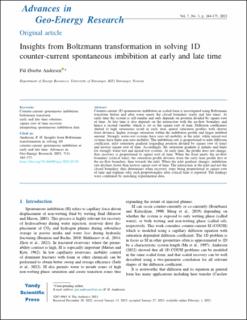| dc.contributor.author | Andersen, Pål Østebø | |
| dc.date.accessioned | 2023-06-26T11:28:03Z | |
| dc.date.available | 2023-06-26T11:28:03Z | |
| dc.date.created | 2023-01-19T09:39:46Z | |
| dc.date.issued | 2023 | |
| dc.identifier.citation | Andersen, P.Ø. (2023) Insights from Boltzmann transformation in solving 1D counter-current spontaneous imbibition at early and late time. Advances in Geo-Energy Research, 7 (3), 164-175. | en_US |
| dc.identifier.issn | 2207-9963 | |
| dc.identifier.uri | https://hdl.handle.net/11250/3073216 | |
| dc.description.abstract | Counter-current 1D spontaneous imbibition in scaled form is investigated using Boltzmann transform before and after water meets the closed boundary (early and late time). At early time the system is self-similar and only depends on position divided by square root of time. At late time it also depends on the interaction with the no-flow boundary and hence a second variable, which is set as the square root of time. Diffusion coefficients shifted to high saturations result in early time spatial saturation profiles with shorter front distance, higher average saturation within the imbibition profile and larger imbibed amount. Strongly water-wet systems have zero oil mobility at the inlet, while mixed-wet systems have finite non-zero mobility. The imbibition rate is proportional to inlet diffusion coefficient, inlet saturation gradient (regarding position divided by square root of time) and inverse square root of time. Accordingly, the saturation gradient is infinite and finite for strongly water-wet and mixed-wet systems. At early time, the profile does not change, thus recovery is proportional to square root of time. When the front meets the no-flow boundary (critical time), the saturation profile deviates from the early time profile first at the no-flow boundary, then towards the inlet. When the inlet gradient changes, imbibition rate declines faster than inverse square root of time. The interaction at the inlet and not the closed boundary, thus determines when recovery stops being proportional to square root of time and explains why such proportionality after critical time is reported. The findings were confirmed by matching experimental data. | en_US |
| dc.language.iso | eng | en_US |
| dc.publisher | Ausasia Science and Technology Press Pty. Ltd | en_US |
| dc.rights | Attribution-NonCommercial-NoDerivatives 4.0 Internasjonal | * |
| dc.rights.uri | http://creativecommons.org/licenses/by-nc-nd/4.0/deed.no | * |
| dc.title | Insights from Boltzmann transformation in solving 1D counter-current spontaneous imbibition at early and late time | en_US |
| dc.type | Peer reviewed | en_US |
| dc.type | Journal article | en_US |
| dc.description.version | publishedVersion | en_US |
| dc.rights.holder | © The Author(s) 2023. | en_US |
| dc.subject.nsi | VDP::Teknologi: 500::Berg‑ og petroleumsfag: 510 | en_US |
| dc.source.pagenumber | 164-175 | en_US |
| dc.source.volume | 7 | en_US |
| dc.source.journal | Advances in Geo-Energy Research | en_US |
| dc.source.issue | 3 | en_US |
| dc.identifier.doi | 10.46690/ager.2023.03.03 | |
| dc.identifier.cristin | 2109999 | |
| dc.relation.project | Norges forskningsråd: 331644 | en_US |
| cristin.ispublished | true | |
| cristin.fulltext | original | |
| cristin.qualitycode | 1 | |

